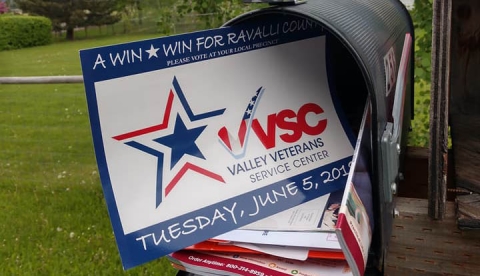Montana’s first county veteran service office serves as model for state

Key Takeaways
The wide-open spaces that draw many to Montana’s Big Sky Country can be less appealing when it means traveling eight hours to reach services people need. The reality of driving two hours to a Walmart is part of the trade-off people make to live where they want, but when it comes to the more specialized needs of veterans who need help accessing services, that distance becomes a liability. Often one that can take up to eight hours.
“In northeastern Montana, that’s how far people are traveling to get to veterans services,” said Mike Warner, veterans service officer in the Valley Veterans Service Center in Ravalli County. “Some of our state’s veterans have a long way to go, even for Montana’s standards.”
Learn More
It’s the fourth-largest state, home to roughly 98,000 veterans as of 2016 and 23 veterans service officers. North and South Dakota, by comparison, are roughly the same size, combined, and serve roughly 14,000 more veterans with 109 veterans service officers. That imbalance righted itself slightly this year when citizens of Ravalli County voted for a levy to fund the county’s veterans service office, the first in the state run by a county, which allowed the office to hire two additional staff members.
That additional levy increased the veterans’ service center’s budget to $247,000 from its previous $85,000 budget. It’s the latest step in a three-year-old effort that Warner hopes can be a model for other counties throughout the state.
“The passage of the mill levy demonstrated the nature of our community and its support for our veterans,” said Commissioner Greg Chilcott. “This was originally a grassroots effort by our veterans, they were being underserved, and we knew we could do better.”
Ravalli County's 4,423 veterans accounted for 13.5 percent of the county's population in 2016.
Warner has been there for the office’s growth. In 2015, when he was the only staff member, he managed a caseload of roughly 250. Now, the office helps more than 1,800 veterans access services through the federal Veterans Administration bureaucracy — which has averaged out to more than one new veteran signing up for services every day.
“It’s amazing to me that three years ago we didn’t have a working computer, and now we have a place that veterans’ groups from all over can call home,” he said. “We have four full-time staff members, five work-study positions and a counselor five days a week, all thanks to the Ravalli County community.
“Their support in passing that levy shows how much our citizens value our veterans and want them to have the resources they need.”
The Valley Veterans Service Center — it kept its original name as an homage to the Vietnam veterans group that spearheaded the county’s first veterans service efforts eight years ago — started in earnest in 2015 when the county hired Warner as its veterans service officer.
“I worked out of a house that wasn’t wheelchair accessible, which wasn’t ideal for a county with a lot of older, Vietnam-era veterans,” Warner said. “I opened a binder my first day and there were actual cobwebs inside.”
The county offered used computers to help get the VSO started, and Warner and Dan Griffin, who was hired a year later, demonstrated the service that won over Ravalli County voters.
“The levy passed with 78 percent of the vote, which is the highest any mill levy has passed in Ravalli County,” Warner said. “Our citizens have stepped up and that’s a vote of confidence and a sign we’re on the right track. They don’t want our veterans to lack services.”
Warner said his office has seen veterans come from hours away to sign up for VA services. That kind of need in other counties is reason enough for him to pitch Ravalli County’s veterans service office structure to other counties — there’s certainly a need for local help for veterans.
“There’s the question of where counties can begin. Well, you have veterans in your community, so that’s the best place to start,” Warner said. “These are people who are trained to be leaders, if you get a whole bunch of leaders together, there’s nothing they can’t overcome.”
Warner is pleased with the success of his VSO’s recruitment efforts given the cultural aspects of many Montana veterans.
“This is a place where a lot of people come to be left alone,” he said. “We have a lot of ex-Special Forces guys who own their property in the woods and want to be left alone. If they come out to engage with us, that’s a sign we’re doing something right.”
NACo County Explorer data on veterans
New data in November
644 | Veteran Expenditures
644 counties each received over $50 million in Veterans Affairs (VA) benefits in 2017 within their jurisdictions. |
39% | VA Medical Care Expenditures
Medical care accounted for more than 39% of all VA expenditures in FY 2017. |
37% | Veteran Demographics
37% of counties have veterans comprising more than 10 percent of the adult population. |
41% | Drug-Related Offenses
41% of opioid-related offenses in counties involved prescription opioids in 2016. *This includes offenses associated with crime incidents that were reported by law enforcement agencies that participate in the National Incident Based Reporting System (NIBRS). |
28% | Dams
28% of all dams across the nation are owned by local governments. |

Attachments
Related News

Counties Mark Five Years of Operation Green Light for Veterans
County buildings and landmarks light up in green November 4-11, showing support and highlighting resources available for veterans and their families

Highlights from 2025 Operation Green Light for Veterans
Operation Green Light for Veterans returns. Explore highlights from counties across the country.

County service meets a veteran’s need for purpose in Spotsylvania County, Virginia
After Drew Mullins transitioned from a high-performance lifestyle in the military, he found the environment and purpose he sought when he took office in his county.
